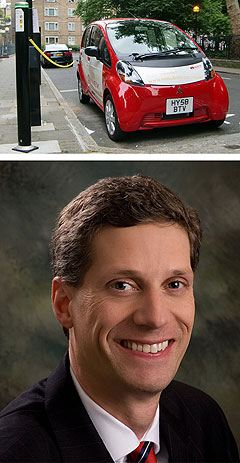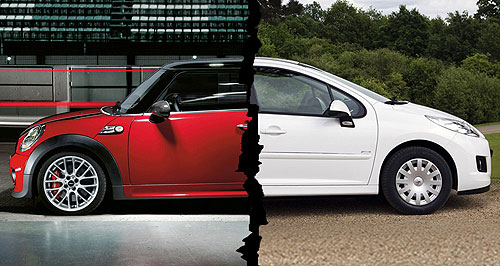Make / Model Search
News - General NewsCommon engines tech 'could transform car industry'Shared future: BMW's Mini and Peugeot's 207 are just two cars already sharing powertrain technology. Changing environment puts global drop-in engines and electric powertrains on agenda22 Oct 2009 By TERRY MARTIN INTERNATIONAL standards that require all car manufacturers to use the same basic design for small combustion engines and electric powertrains are now on the agenda as environmental issues and economic conditions become more acute, according to the global chief executive of the Society of Automotive Engineers (SAE). In an exclusive interview with GoAuto this week, SAE International CEO David Schutt said the global automotive industry needed to be more effective in harmonising standards and increasing the “pre-competitive” side of their operations, such as using common powertrain designs and technologies. Dr Schutt also said he expected powertrain alliances to broaden between rival manufacturers, such as those now in place between European marques BMW, Daimler and PSA Peugeot-Citroen, which will enable them to keep research and development costs down and still meet increasingly stringent environmental standards. “The auto industry, I don’t believe, has been as effective as it can be in using standards to harmonise things the world over,” Dr Schutt told GoAuto. “SAE International also deals with the aerospace and the commercial vehicle industries, and particularly the aerospace industry has taken advantage of standards much further down the manufacturing line.  Left: Mitsubishi i-MiEV plug in. Below: SAE CEO David Schutt. Left: Mitsubishi i-MiEV plug in. Below: SAE CEO David Schutt.“They have a lot more (scope) in the pre-competitive side of their design and their activities, and they use standards much more effectively.” While increasing the number of common drop-in components will, in the short term, be a decision left to the original equipment manufacturers (OEMs), Dr Schutt said he anticipated a sharp rise in the number of business cases supporting the trend. Increased globalisation of vehicle design rules is also expected. “My anticipation is that you’re going to see that both within major OEMs as well as the beginning of stronger co-operation across OEMs in developing those standards, where there is a pre-competitive notion,” he said. “(There are) discussions about whether there will become standard powertrains at the low end – the 1.4, 1.6-litre four-cylinder engines … (and) I think there is going to be some business cases for that on many occasions. “The automobile industry is going to become far more competitive – and it is going to become more expensive. Let’s just take powertrains, for example. Powertrains are extraordinarily sophisticated today, and they’re going to get more sophisticated in the future, trying to meet the different environmental standards and in dealing with different fuels and different regions. “It’s going to become very difficult for any individual company to actually have a competitive edge, or have the ability to develop sophisticated powertrains. So I would see some of those partnerships beginning to develop, as they have already, and growing into the future.” Dr Schutt said that providing a powertrain was sufficiently sophisticated, the different car brands in an alliance would be able to make engineering adjustments to ensure it stuck with traditional brand values. “Whether you buy a BMW, or whether you buy a Chrysler or a General Motors car, whether it be a Cadillac or a Chevrolet, there is some tuning that can go on to give it the feel of that brand,” he said. Representing 121,000 members worldwide across 110 countries, SAE International is also working with manufacturers, suppliers, governments, consumer organisations and power companies to ensure common and relevant technical standards are in place in the emerging electric vehicle (EV) field. “The notion of the electrification of the automobile is an area that … is going to become a very prominent part of the industry and so we want to be developing the programs and services that they need to help accelerate that process,” he said. “We are less than a month away from introducing a suite of standards that will standardise everything from the shape of the plug that goes from the wall to the car itself … so we want to get out in front of that and standardise that. It can help eliminate a tremendous amount of cost from the industry, as well as cost from the consumer perspective. “The standards are also going to go into the area of how the vehicle actually communicates with the grid, as the electricity flows back and forth, getting into a sophisticated power grid in terms of the timing of when the car is being charged and whether there’s excess capacity with the battery that can be feeding back into the grid. “There is a little bit of natural tendency of regions in the world to compete with one another, but SAE is very active in trying to reach out to all aspects of the world where they have a say and a desire to try to standardise these activities.” Dr Schutt said it was vital that the standards had market relevance as well as technical excellence, arguing the case for a common approach to the burgeoning EV market rather than individual car manufacturers forging alliances with certain infrastructure providers that could prove incompatible for other vehicles. “To have a harmonised approach is going to be the only way that we can do this cost-effectively,” he said. “To have individual companies or individual suppliers saying, ‘This is what it’s going to be’ will be to the detriment of these newer technologies. “We’re trying to engage all of those stakeholders in that broader conversation early on. In the end, it will help get cost out of the system for everyone – from the design to the manufacturer to the consumer, as well as the supplier of the electricity or the bio-fuels or whatever the case may be. “Let’s harmonise those approaches early on.”  |
Click to shareGeneral News articlesResearch General News Motor industry news |









Facebook Twitter Instagram